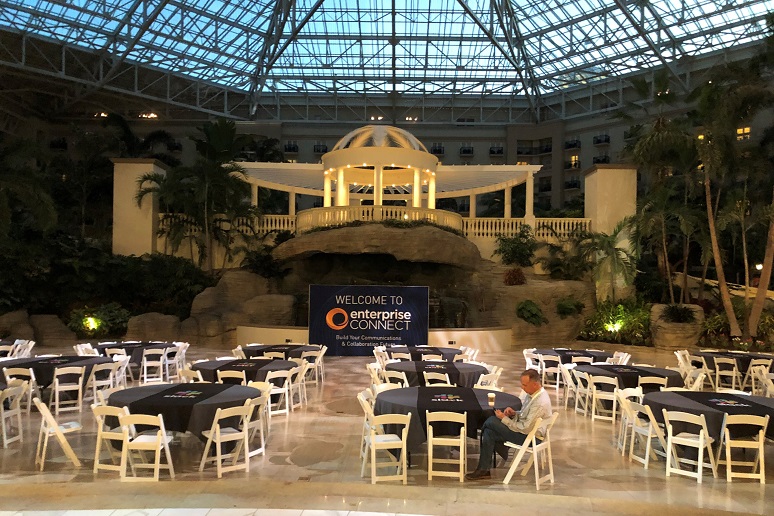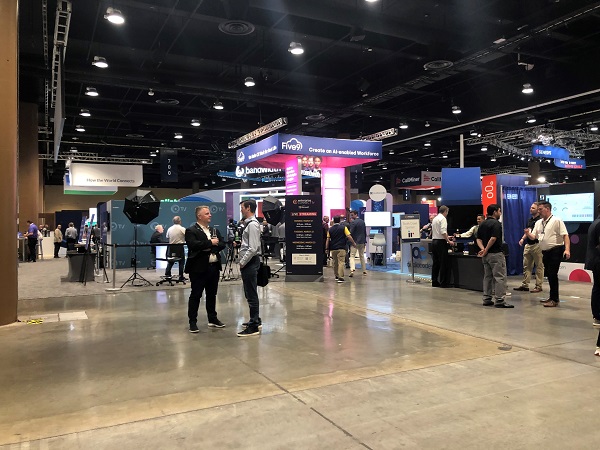Confession time: I had never gone to a trade show, much less the trade show that is the industry’s biggest event for enterprise communications. And my previous job didn’t require travel. So now that I work someplace that does require travel to the biggest event for enterprise communications, I was anxious. As pre-show prep, I turned to expert attendees for their advice on
how to have the best Enterprise Connect experience possible.
Thanks to the experts, I knew to prepare for walking and to prepare for working on the go. On the Monday morning of the event, I put on my most comfortable sneakers (arch support included) and strapped band-aids to my ankles (as recommended by the experts). Then I slung my backpack over both shoulders. The backpack held what was basically a mobile office where I could do any part of my job—a laptop, numerous chargers, notebooks, pens, earbuds, headphones, and two recording devices (just in case).
I’d prepped with expert advice; it was time to see if the best practices applied to a show novice. Here’s what I got out of the next four days.
Lesson One: Virtual events are great for learning from people; in-person events are great for engaging with people.
Virtual events allow attendees to browse content at their own pace, but they don't offer attendees the same level of interpersonal interactivity as in-person events. After having attended virtual events, it was clear that attending panels in person kept attendees more engaged because they could respond and react—and many didn’t hesitate to step up to the microphone and ask questions when a session was over. Virtual events also tend to be less spontaneous in the sense that the speakers appear to have scripts in front of them and read lines as if they are the only person in the room—which they likely are. On stage, the speakers seemed more responsive because when everyone is in the same place, having a similar experience, energy is present that technology has yet to match.
Lesson Two: Spending a day learning about enterprise communications helps create unexpected leaps of understanding in broader industry trends.
When I scurried over to Blair Pleasant’s presentation,
UCaaS Plus CCaaS: What's Real, What's Hype, and What's Next, I nearly missed the line outside the door. Accompanying Pleasant on stage was:
Dhwani Soni, VP product and UX design 8x8;
Fabrice Della Mea, senior director product, Dialpad;
Jack Nichols, VP product management, Genesys Cloud CX, Genesys, and
Sanjay Srinivasan, SVP & chief technology architect, Vonage to discuss how UCaaS and CCaaS work better together.
Pleasant described how “I’ll put you on hold” and “Let me call you back” are phrases that don’t necessarily lead to a good experience—yet they’re phrases consumers hear the most. She went on to say that by combining UCaaS and CCaaS, the agent gains access to instant messaging, can see which subject matter experts are available, and collaborate in a shared space—all of which leads to first-contact resolution. The term “first-contact resolution” made me wonder how many companies achieve it with customers. I also unlocked a memory of something I read from Dave Michels, contributing editor and analyst at TalkingPointz. He described how clothing retailer
Forever 21 re-evaluated its customer experience (CX) and customer engagement approach by implementing a Huddle platform from CCaaS startup Edify. What struck a chord with me was how an employee with an iPad could answer the phone and then use the camera to show customers available in-store options. It’s solutions like these that I believe have the potential to bridge the gap between the employee and customer experience.
Also filling in the holes between the employee and customer experience is Juanita Coley, founder, and CEO, of Solid Rock Consulting. When explaining which WFM tools companies should consider, she touched on company culture and why companies must first look at their employee experience and customer experience initiatives and determine if that ties into the culture. Coley also elaborated on why the employee experience is the core of customer experience, and I couldn’t help but hear a few giggles when Coley leaped straight to the point. “If your data is trash—trash in equals trash out,” she said. In her presentation,
Your WFM Solution Alone Can’t Save You, Coley described Chick-Fil-A's company culture where employees always greet customers with a smile. The more appreciated and valued your employees feel, the harder they work to succeed and help the company succeed—and it begins with company culture.
Customer experience was another common theme across
Overcoming Real-World Obstacles to Transforming CX, a breakout session led by Elizabeth English, No Jitter contributor and founder and principal of EE and Associates. Craig Robinson, director, StableLogic Ltd., and Ari Reingowsky, president, Trien & Associates, Inc., joined English to discuss use case examples, plus common themes and challenges surrounding customer experience (CX) transformations.
Robinson provided a use case example of a Global Fintech organization with significant operations in Europe, the U.S., South Africa, Japan, and Australia. The organization's objective was to transition from a traditional contact center environment to an omnichannel approach. Robinson said when clients move communications or customer contact away from voice to omnichannel, they provide high-quality services, and customers enjoy them because they’re served as “effectively as possible.” What struck me most about Robinson's use case explanation was when he said the "culture of the organization is critical...you have to get the culture right."
Lesson Three: Sitting in on keynotes and best of show events is a great way to see the future of enterprise communications
Dave Michels took the stage as the emcee for
Enterprise Connect 2022’s Innovation Showcase, where the theme of customer experience and engagement continued. Six companies—Airkit, Balto, Cognigy, Invoca, Ujet, and Pathlight—had six minutes to explain what differentiated their solutions and share how their customers have used them to improve customer engagement.
The Innovation Showcase laid out different products and why they were the way forward:
- Airkit enables any enterprise to create a rich digital experience by unifying data, omnichannel, and multichannel interactions with customers in a single location.
- Balto uses AI to guide agents to say the right thing on every call. It not only coaches but also learns as it constantly assesses the effectiveness of specific phrases. Balto also automatically scores 100% of calls, so businesses can concentrate on improving customer conversations.
- Cognigy’s platform features a low-code graphical editor for the simplified creation of human-like, multilingual, and multichannel virtual bots. Invoca’s conversational AI platform analyzes customer conversations and delivers insights and tools to provide consistent customer experience across digital and human touch points.
- Pathlight analyzes performance data across all systems for customer relationship management plus AI and coaching, so a team knows exactly where to focus.
- Lastly, Ujet provides a mobile-first CCaaS service with advanced mobile features like Face ID authentication, video calling, tap-to-pay, and rich messaging.
Lesson Four: There’s no energy like show floor energy
The second I opened the doors to the show floor, the hardware smell permeated the perimeter. Everywhere I looked, readers and attendees were immersed in technology demonstrations. I stopped by Vonage, Twilio Flex, Ujet, and Cognigy for a glimpse of where contact center and customer experience technology are heading.
In addition to the emphasis on customer experience, other themes I noticed on the show floor were sentiment analysis and empathy and how to incorporate both in the contact center. For example,
Genesys recently partnered with Thrive, a behavior change technology company, to develop a solution where organizations can embed well-being tools directly in the workflow so workers can de-stress, reset, and recharge in real-time.
Jack Nichols, VP product management, Genesys CX, demonstrated how Thrive for Genesys works. When I asked him why Genesys sought out this technology, Nichols summarized the company's mission to end employee burnout by explaining how contact center agents deal with frustrated customers regularly, often one after the other, with no break in between. Meanwhile, this empathy-enabled technology appears on the screen in short video form after a call ends. Agents can choose between six videos to watch. They can meditate for 10 minutes to reset, exercise to refresh, or even take a dance break to re-energize. Companies can also customize the timing of the breaks to address their employees’ specific needs.
I asked Nichols how connected Genesys employees were with this technology. He said that it’s already increasing employee well-being and customer satisfaction—well, the employee is the customer after all—and happier employees mean a Great Retention vs. Great Resignation.
Lesson Five: Socializing and engaging in person is an experience we still can’t replicate online—yet
To reiterate, a virtual handshake isn’t the same as an in-person one, and no technology has yet to replicate an embrace over a laptop screen. Having casual conversations with industry experts and in-person workplace huddles with colleagues helped me narrow down which conversations truly matter.
For example, at the
Women in Communications Roundtable: Spotlighting Excellence panel, four high-level IT execs shared their expertise and explained why they’re frequently the only female in the room. I was inspired not only by how they put a few men in their place when it came to launching their company's cloud migration but also by their admission to dealing with imposter syndrome in the workplace. As a copywriter with an extended background in different areas—I couldn’t help but relate. It’s not always easy for a small fish to find its place in a big pond.
Spotlight Award winner,
Danielle Joiner McPherson, director of global reservations tech and innovation, Delta Airlines, mentioned the significance of self-talk because what we tell ourselves is what we become and what we believe—and most of us are stronger than we think. Having chatted with readers and attendees from all walks of life—end-users, subject matter experts, CEOs, and CIOs—the engagement and seeing others explore their passions has aided me in expanding my arsenal of knowledge in enterprise communications.
In retrospect, I collected many valuable insights from my expert contributors. The most memorable piece of advice I received was that it’s impossible to avoid information overload. There’s so much to learn and so little time to absorb it all.
At Enterprise Connect 2023, I'm excited to see what vendors that didn't make it this year will be on the expo floor—where I expect to spend more time. I also wonder if Jon Arnold’s sixth installment of the “
State of the Speech and Voice Recognition Market” will emphasize metaverse collaboration as the future of the desktop becomes more mobile. As an admirer of augmented and virtual reality (AR/VR), I’ll also anticipate how its presence will evolve in the enterprise—will we all be wearing VR headsets to work as avatars in a virtual office? Will I be able to project a hologram of myself onto my colleagues’ desks to wish them a good day? I guess we’ll have to wait and see.
An off-the-record comment about showing up to the event better than the year before also inspired me—because I plan to do just that. Now that my feet are wet in the innovative world of Enterprise Connect (and business travel)—and I know how to prepare for ultimate comfort—I'm looking forward to personal and professional growth in the coming year—and maybe a new pair of memory foam sneakers.










